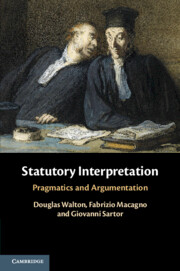Book contents
- Statutory Interpretation
- Statutory Interpretation
- Copyright page
- Dedication
- Contents
- Figures
- Tables
- Acknowledgments
- Introduction
- 1 Interpretation and Statutory Interpretation
- 2 Statutory Interpretation as Problem Solving
- 3 Interpretation and Pragmatics – Legal Ambiguity
- 4 Pragmatic Maxims and Presumptions in Legal Interpretation
- 5 Arguments of Statutory Interpretation and Argumentation Schemes
- 6 Classification and Formalization of Interpretative Schemes
- References
5 - Arguments of Statutory Interpretation and Argumentation Schemes
Published online by Cambridge University Press: 29 December 2020
- Statutory Interpretation
- Statutory Interpretation
- Copyright page
- Dedication
- Contents
- Figures
- Tables
- Acknowledgments
- Introduction
- 1 Interpretation and Statutory Interpretation
- 2 Statutory Interpretation as Problem Solving
- 3 Interpretation and Pragmatics – Legal Ambiguity
- 4 Pragmatic Maxims and Presumptions in Legal Interpretation
- 5 Arguments of Statutory Interpretation and Argumentation Schemes
- 6 Classification and Formalization of Interpretative Schemes
- References
Summary
As shown in the previous chapters, interpretation is at the crossroad between linguistics – and in particular pragmatics – and legal theory. When we analyzed the relationship between the Gricean and neo-Gricean pragmatic frameworks and the instruments used in legal interpretation, we pointed out the role of presumptions and defeasibility in assessing the strength of an interpretation. In this perspective, pragmatic maxims and interpretative canons are both useful tools for justifying an interpretation, but alone do not provide any criteria for establishing the superiority of an argument – and consequently of a justified interpretation – over another. In our previous chapter, we pointed out how a hierarchy of presumptions based on their defeasibility conditions can guide the process of assessment. In this view, the less defeasible arguments are those that are based on specific presumptions, namely defeasible generalizations linking an interpretation to specific features of a text or co-text.
- Type
- Chapter
- Information
- Statutory InterpretationPragmatics and Argumentation, pp. 205 - 279Publisher: Cambridge University PressPrint publication year: 2021
References
References
Cases Cited
Adams v. New Jersey Steamboat Co. 1896. 151 N.Y. 163.
Arnold v. Producers Fruit Co. 1900. 61 P 283.
Bank One Chicago, N.A. v. Midwest Bank & Trust Co. 1996. 516 U.S. 264.
Bekteshi v. Mukasey 2007. 260 F. App’x 642.
Cassazione penale, sez. III, sentenza 26/09/2008 n° 36845
Cassazione penale, sez. V, sentenza 11/01/2019 n° 1275
Circuit City Stores, Inc. v. Adams 2001. 532 U.S. 105.
Conroy v. Aniskoff 1993. 507 U.S. 511.
Corley v. United States 2009. 556 U.S. 303.
Corte Costituzionale. Sentenza n. 138/2010. ECLI:IT:COST:2010:138.
Corte Costituzionale. Sentenza n. 280/2010. ECLI:IT:COST:2010:280.
District of Columbia v. Heller 2008. 554 U.S. 570.
Garner v. Burr [1951] 1 KB 31.
Google Spain SL, Google Inc. v. Agencia Española de Protección de Datos (AEPD), Costeja Gonzalez 2014. ECLI:EU:C:2014:317.
Healthkeepers, Inc. v. Richmond Ambulance Authority 2011. 642 F.3d 466.
James v. United States 2007. 550 U.S. 192.
Johnson v. United States 2015. 576 U.S. 591.
Leatherman v. Tarrant County Narcotics Intelligence & Coordination Unit 1992. 507 U.S. 163.
Obergefell v. Hodges 2015. 135 S. Ct. 2584.
People v. Collins 2005. 214 Ill. 2d 206.
People v. Davis 2008. 218 P.3d 718.
Popov v. Hayashi 2002. WL 31833731.
State v. Taylor 1999. 594 N.W.2d 533.
Taylor v. United States 1990. 495 U.S. 575.
United States v. Barber 2005. 360 F. Supp. 2d 784.
United States v. California 1965. 381 U.S. 139.



